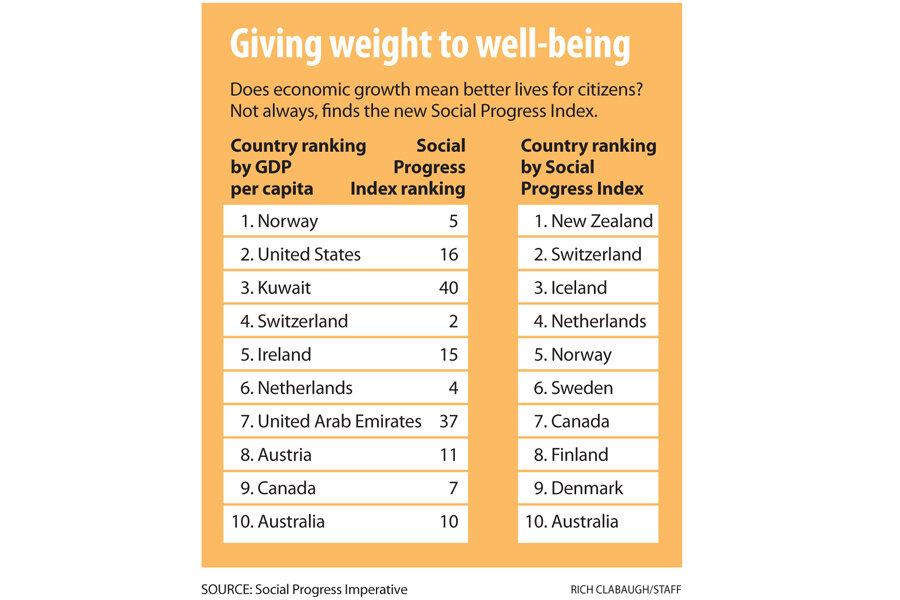Social Progress Index: Why does US rank No. 16?
Loading...
The United States remains unmatched by any other large economy when measured by per-person income, but by a new measure of “social progress,” it’s way behind – No. 16 – in delivering a high-quality life to its citizens. That’s the message of the Social Progress Index, a barometer released this month that offers a window into the well-being of people in 132 nations.
1. What is 'social progress' and why is it important to measure?
For decades, the value of goods and services exchanged (gross domestic product per person) has been used as a proxy for the well-being of average citizens. But for just as long, GDP per capita has been acknowledged as an imperfect benchmark for human progress.
“If we have the wrong metrics, we will strive for the wrong things,” a trio of prominent economists opined in one report after the 2008 financial crisis.
The new index, put out by a nonprofit group called the Social Progress Imperative, is an attempt to address the problem. It’s not the only such effort, but it’s ambitious in its scope, ranking nations on 54 indicators that cover everything from social inclusion to environmental stability and literacy rates.
“It’s a measure of what is a good society,” says Michael Green, the group’s executive director.
2. What are some of this report’s key findings?
Some nations pull above their weight when it comes to converting dollars of output into social progress. According to the Social Progress Index, these include New Zealand (No. 1) and many European nations but also Costa Rica and a number of South American nations including Brazil and Uruguay.
The US is far from alone in the other camp – nations where the GDP dollars don’t seem to be matched by social progress. The world’s two most populous nations, China and India, are rightly viewed as up-and-comers in economic clout, but the index suggests they aren’t fully translating that GDP growth into better lives for their citizens.
If the index reveals the gaps between economic and social progress, that doesn’t mean GDP growth is meaningless. In fact, another big lesson of the results is that the two kinds of progress are closely intertwined.
But societies that lack things such as social inclusiveness and political freedom will lag far behind their potential (Turkey and Russia are examples, the index finds). Those problems may restrain economic growth. They’ll also mean that citizens reap below-normal well-being from the GDP that’s already on the books.
“While higher GDP per capita is correlated with social progress, the connection is far from automatic,” index designer Michael Porter, a Harvard University economist, said in releasing the report.
3. How do these results differ from other comparative indexes?
Similar patterns are visible in the UN Human Development Indicators and in the World Economic Forum’s competitiveness rankings, but the Social Progress Index has this distinction: Its components are all non-economic measures of well-being. That can make it useful as a “purely social” comparison with economic gauges (such as GDP per capita) or blended indexes (such as the United Nations numbers).
4. How is this index created?
The index is a composite of three different scores, each based on numerous underlying data points. The first score is for meeting “basic needs,” drawing on nutrition, water, and public safety data.
The other two rungs on the index’s progress ladder are “foundations of well-being” (performance in areas such as public schooling and ecosystem sustainability) and “opportunity” (such as personal rights and the society’s tolerance for diversity). The index has been refined and relaunched after a debut last year.
5. Can the information be put to use in practical ways?
That’s what the nonprofit group behind it hopes and expects. Mr. Green, the Social Progress Imperative’s executive director, says some policymakers and nonprofit groups are already looking at the numbers as a guide to needs and priorities.
For each country, components of the index reveal shortcomings and strengths relative to peer nations. The US, for example, could close some gaps by keeping more children in school and improving health (a shortcoming despite world-leading medical expenditures).








